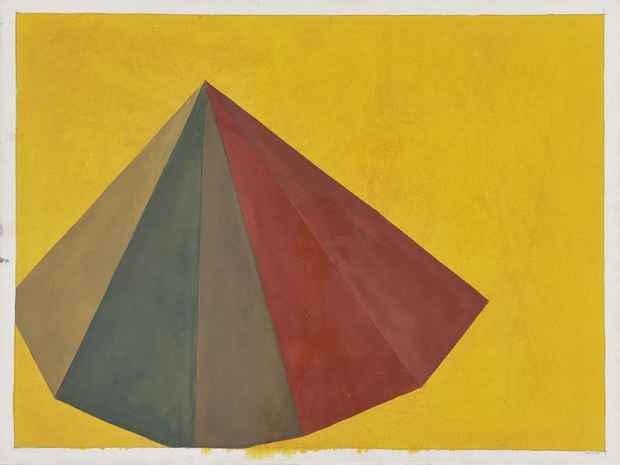“From Point to Line” Exhibition
Senior & Shopmaker Gallery

[Image: Sol LeWitt "Pyramid" (1986) gouache on paper 22 x 30 in.]
This event has ended.
Senior & Shopmaker present From Point to Line, a group exhibition of works by artists whose common approach towards minimal, reductive imagery reveals remarkable diversity of expression. Whether relying on mathematical concepts or intuitive forms of drawing, the placement and meaning of line is central to the artists’ intentions.
Artists such as Mel Bochner, Sol LeWitt, and Dorothea Rockburne use line and geometry to define spatial relationships and conceptual frameworks for artmaking. In LeWitt’s 1973 print portfolio, The Location of Lines, specific written instructions provided by the artist are incorporated as part of the image itself. The conceptual process is transparent and accessible, allowing the viewer to trace the evolution of what is intended as a large wall drawing. Mel Bochner’s 1997 wood engraving, 12” x 3”, presents an objective exercise in measuring the space between specified spaces or points—the distance between the edges of an etching plate, or the edges of the paper support. Though based on rational principles, its tongue in cheek rationalism reveals the vacuous nature of the endeavor. Dorothea Rockburne studied mathematics with Professor Max Dehn at Black Mountain College, and her fascination with proportion, geometry, and the Golden Ratio are found in her cut and folded drawings and works on paper. While Robert Mangold is no less interested in geometry, he uses line in a more lyrical way to reinforce the two-dimensional plane of paintings, drawings, and prints.
In works on paper by Edda Renouf and Gunther Uecker line is a means of exploring the physical process of drawing and inherent nature of their materials. Renouf‘s drawings are built up with layers of pastel upon which, using an etching needle, she incises vertical or horizontal lines to lift the fibers of the paper. While generally ordered, Renouf’s drawings synthesize the organic and the geometric. Vera Molnar’s disrupted computer algorithms and Lee Ufan’s repetitive linear mark-making exploit the phenomena of chance and the unexpected in the drawing process.
Richard Tuttle’s wire sculptures of the 1970s combined the essential qualities of drawing and sculpture, as did Fred Sandback’s yarn sculptures that defined space and volume of the architectural environment with the sparest of means. In their drawings and prints, line is used to create the illusion of spatial depth and perceptual shifts. In works on paper by environmental artists Mary Miss and Agnes Denes, line is used diagrammatically to relate to actual structures or the mapping of real or theorized spatial domains. Miss’s Drawing for Field Rotation, 1981 is a study for an earthwork sculpture in Nathan Manilow Sculpture Park, University Park, IL incorporating 125 wooden poles that radiate in eight lines from the center gently defining the slope of the landscape.
Media
Schedule
from April 20, 2016 to June 18, 2016